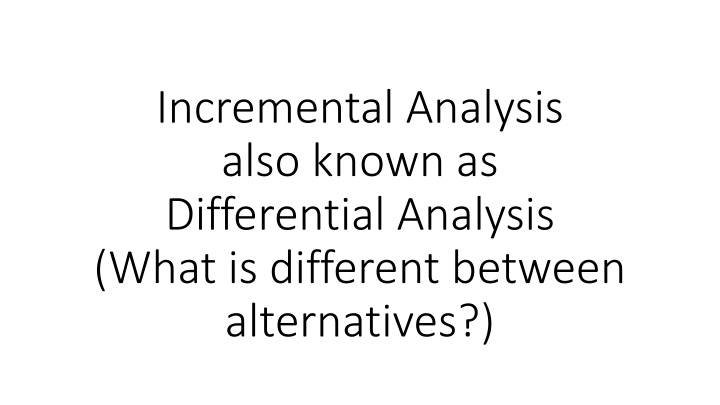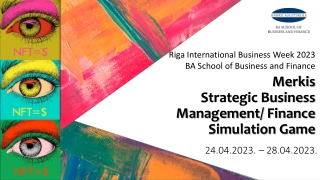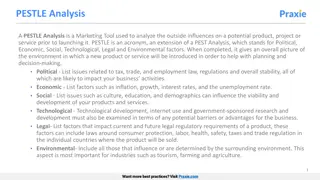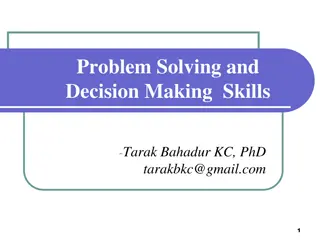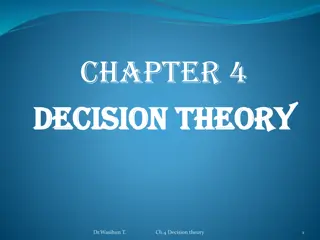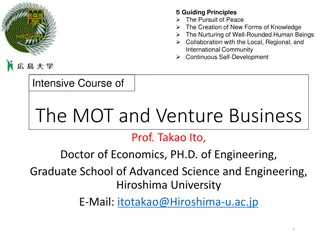Strategic Analysis in Business Decision-Making
Incremental analysis, also known as differential analysis, helps in comparing alternatives by identifying differences. Special orders and make-or-buy decisions are integral parts of strategic decision-making. Evaluating special orders involves calculating incremental revenue and costs, while make-or-buy decisions consider the value chain activities in providing products or services. Understanding these concepts can guide managers in making effective business decisions to maximize profits and efficiency.
Download Presentation

Please find below an Image/Link to download the presentation.
The content on the website is provided AS IS for your information and personal use only. It may not be sold, licensed, or shared on other websites without obtaining consent from the author.If you encounter any issues during the download, it is possible that the publisher has removed the file from their server.
You are allowed to download the files provided on this website for personal or commercial use, subject to the condition that they are used lawfully. All files are the property of their respective owners.
The content on the website is provided AS IS for your information and personal use only. It may not be sold, licensed, or shared on other websites without obtaining consent from the author.
E N D
Presentation Transcript
Incremental Analysis also known as Differential Analysis (What is different between alternatives?)
Special Orders Special Orders Managers must often evaluate whether a special order should be accepted, and if the order is accepted, the price that should be charged. A special order is a one-time order that is not considered part of the company s normal ongoing business. Step 1: Calculate the total revenue generated by the special order. Step 2: Calculate the total incremental costs that will be incurred to produce the special order.
BE14.3 At Bargain Electronics, it costs $30 per unit ($20 variable and $10 fixed) to make an MP3 player that normally sells for $45. A foreign wholesaler offers to buy 3,000 units at $25 each. Bargain Electronics will incur special shipping costs of $3 per unit. Assuming that Bargain Electronics has excess operating capacity, indicate the net income (loss) Bargain Electronics would realize by accepting the special order.
Make or Buy Decision Make or Buy Decision Providing a product or service to a customer involves many steps. For example, consider all of the steps that are necessary to develop and sell a product such as a fitness watch. First, engineers need to develop the underlying electronics that provide customers with capabilities such as real-time GPS tracking, heart rate monitoring, and activity monitoring. In addition, they need to design a wrist watch that not only houses the electronic circuitry, but that also meets the customers needs in terms of aesthetics, durability, and functionality. Second, the watches need to be assembled, tested, individually packaged, and then boxed in larger quantities to enable shipping. Third, the finished goods need to be transported to retail sales locations and eventually sold to customers. Finally, the company needs to provide after-sale service such as Internet and phone-based help lines, warranty claims, and product returns. All of these activities, from development, to production, to after- sales service are called a value chain.
Separate companies may carry out each of the activities in the value chain or a single company may carry out several. When a company is involved in more than one activity in the entire value chain, it is vertically integrated. Some companies control all the activities in the value chain from producing basic raw materials right up to the final distribution of finished goods and provision of after-sales service. Other companies are content to integrate on a smaller scale by purchasing many of the parts and materials that go into their finished products. A decision to carry out one of the activities in the value chain internally, rather than to buy externally from a supplier, is called a make or buy decision. Quite often these decisions involve whether to buy a particular part or to make it internally. Make or buy decisions also involve decisions concerning whether to outsource development tasks, after-sales service, or other activities.
Strategic Aspects of the Make or Buy Decision Vertical integration provides certain advantages. An integrated company is less dependent on its suppliers and may be able to ensure a smoother flow of parts and materials for production than a nonintegrated company. For example, a strike against a major parts supplier can interrupt the operations of a nonintegrated company for many months, whereas an integrated company that is producing its own parts would be able to continue operations. Also, some companies feel that they can control quality better by producing their own parts and materials, rather than by relying on the quality control standards of outside suppliers. In addition, an integrated company realizes profits from the parts and materials that it is making rather than buying, as well as profits from its regular operations. The advantages of vertical integration are counterbalanced by the advantages of using external suppliers. By pooling demand from many companies, a supplier may be able to enjoy economies of scale.
Use the following three steps to quantify the financial impact of make or buy decisions: Step 1: Calculate the total amount that would be paid to the supplier if the buy option is chosen. Step 2: Calculate the total differential manufacturing costs. These are the variable manufacturing costs and traceable fixed manufacturing costs that will be incurred if the company chooses to make, but avoided if the company chooses to buy.
BE14.4 Manson Industries incurs unit costs of $8 ($5 variable and $3 fixed) in making an assembly part for its finished product. A supplier offers to make 10,000 of the assembly part at $6 per unit. If the offer is accepted, Manson will save all variable costs but no fixed costs. Prepare an analysis showing the total cost saving, if any, that Manson will realize by buying the part.
Joint Product Costs and the Contribution Approach In some industries, a number of end products are produced from a single raw material input. Maria Wool Cooperative of New Mexico buys raw wool from local sheepherders, separates the wool into three grades coarse, fine, and superfine and then dyes the wool using traditional methods that rely on pigments from local materials. Two or more products that are produced from a common input are known as joint products. The split-off point is the point in the manufacturing process at which the joint products can be recognized as separate products. This does not occur at Santa Maria Wool Cooperative until the raw wool has gone through the separating process. The term joint cost is used to describe the costs incurred up to the split-off point. The undyed wool is called an intermediate product because it is not finished at this point. Nevertheless, a market does exist for undyed wool although at a significantly lower price than finished, dyed wool.
At Santa Maria Wool Cooperative, the joint costs are the $200,000 cost of the raw wool and the $40,000 cost of separating the wool. Joint costs are common costs that are incurred to simultaneously produce a variety of end products. These joint costs are often allocated among the different products at the split-off point. A typical approach is to allocate the joint costs according to the relative sales value of the end products. Although allocation of joint product costs is needed for some purposes, such as balance sheet inventory valuation, allocations of this kind are extremely misleading for decision making.
Sell or Process Further Decisions Joint costs are irrelevant in decisions regarding what to do with a product from the split-off point forward. Once the split-off point is reached, the joint costs have already been incurred and nothing can be done to avoid them. None of the joint costs are economically attributable to any one of the intermediate or end products. The joit costs are a common cost of all of the intermediate and end products and should not be allocated to them for purposes of making decisions about the individual products. Decisions of this type are known as sell or process further decisions. It is profitable to continue processing a joint product after the split- off point so long as the incremental revenue from such processing exceeds the incremental processing cost incurred after the split-off point.
For each end product, use the following three steps to make sell or process further decisions: Step 1: Calculate the sales value if processed further minus the sales value at the split-off point. Step 2: Determine the cost of further processing beyond the split-off point. Step 3: Take the amount in step 1 and subtract from it the amount in step 2. If the result is a positive number, then choose to process further. If it is a negative number, then choose to sell at the split-off point.
Each of these products can be sold as is without further processing. It may be that the company would be better off selling one or more of the products prior to dyeing to avoid the dyeing costs. The appropriate way to make this choice is to compare the incremental revenues to the incremental costs from further processing as follows: As this analysis shows, the company would be better off selling the undyed coarse wool as is rather than processing it further. The other two products should be processed further and dyed before selling them. Note that the joint costs of the wool ($200,000) and of the wool separation process ($40,000) play no role in the decision to sell or further process the intermediate products. These joint costs are relevant in a decision of whether to buy wool and to run the wool separation process, but they are not relevant in decisions about what to do with the intermediate products.
As this analysis shows, the company would be better off selling the undyed coarse wool as is rather than processing it further. The other two products should be processed further and dyed before selling them. Total Project Profit Note that the joint costs of the wool ($200,000) and of the wool separation process ($40,000) play no role in the decision to sell or further process the intermediate products. Coarse Wool Fine Wool Superfine Wool Revenue Revenue Revenue 120,000 240,000 90,000 450,000 Further Processing Costs Coarse Wool Fine Wool Superfine Wool (60,000) (10,000) These joint costs are relevant in a decision of whether to buy wool and to run the wool separation process, but they are not relevant in decisions about what to do with the intermediate products. Joint Costs Wool purchase Separation (200,000) (40,000) Total Profit 140,000
BE14.5 Pine Street Inc. makes unfinished bookcases that it sells for $62. Production costs are $36 variable and $10 fixed. Because it has unused capacity, Pine Street is considering finishing the bookcases and selling them for $70. Variable finishing costs are expected to be $6 per unit with no increase in fixed costs. Prepare an analysis on a per unit basis showing whether Pine Street should sell unfinished or finished bookcases.
BE14.6 Each day, Adama Corporation processes 1 ton of a secret raw material into two resulting products, AB1 and XY1. When it processes 1 ton of the raw material, the company incurs joint processing costs of $60,000. It allocates $25,000 of these costs to AB1 and $35,000 of these costs to XY1. The resulting AB1 can be sold for $100,000. Alternatively, it can be processed further to make AB2 at an additional processing cost of $45,000, and sold for $150,000. Each day s batch of XY1 can be sold for $95,000. Or, it can be processed further to create XY2, at an additional processing cost of $50,000, and sold for $130,000. Discuss what products Adama Corporation should make.
BE14.7 Bryant Company has a factory machine with a book value of $90,000 and a remaining useful life of 5 years. It can be sold for $30,000. A new machine is available at a cost of $400,000. This machine will have a 5-year useful life with no salvage value. The new machine will lower annual variable manufacturing costs from $600,000 to $500,000. Prepare an analysis showing whether the old machine should be retained or replaced.
Traceable and Common Fixed Costs and the Segment Margin Three new terms are needed to prepare segmented income statements using the contribution approach traceable fixed cost andcommon fixed cost A common fixed cost (indirect cost) is a fixed cost that supports the operations of more than one segment, but is not traceable in whole or in part to any one segment. Even if a segment were entirely eliminated, there would be no change in a true common fixed cost. For example: A traceable fixed cost (direct cost) of a segment is a fixed cost that is incurred because of the existence of the segment if the segment had never existed, the fixed cost would not have been incurred; and if the segment were eliminated, the fixed cost would disappear. The salary of the CEO of General Motors is a common fixed cost of the various divisions of General Motors. The salary of the Fritos product manager at PepsiCo is a traceable fixed cost of the Fritos business segment of PepsiCo. The cost of heating a Safeway or Kroger grocery store is a common fixed cost of the store s various departments groceries, produce, bakery, meat, and so forth. The maintenance cost for the building in which Boeing 747s are assembled is a traceable fixed cost of the 747 business segment of Boeing.
BE14.8 Lisah, Inc., manufactures golf clubs in three models. For the year, the Big Bart line has a net loss of $10,000 from sales $200,000, variable costs $180,000, and fixed costs $30,000. If the Big Bart line is eliminated, $20,000 of fixed costs will remain. Prepare an analysis showing whether the Big Bart line should be eliminated.
